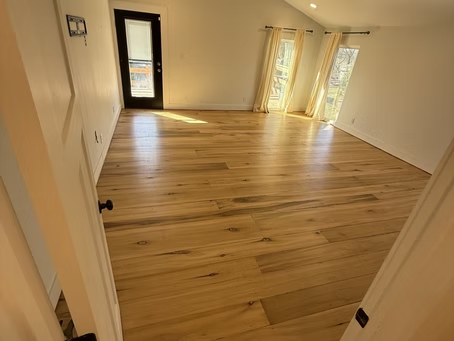For pet owners, flooring isn’t just a design choice—it’s a lifestyle decision. The constant motion of paws, the occasional accident, and daily shedding mean that flooring must be able to withstand more than just regular usage. When selecting flooring for a pet-friendly home, durability, resistance to moisture, and ease of maintenance are essential factors. Some materials are better equipped to handle pets, while others can be more troublesome.
At Insta Pro Construction, we work with a variety of flooring materials and understand the unique challenges pet owners face. In this blog, we’ll be talking about various types of flooring that are ideal for pet owners.
Bamboo Flooring
Bamboo flooring is increasingly recognized as a durable and sustainable option for pet owners. It has a natural hardness that makes it more resistant to scratches than many traditional hardwoods. This is especially beneficial in homes with active dogs, where claws can easily leave visible marks on softer surfaces. Bamboo’s dense structure holds up well to daily traffic and offers a smooth, comfortable walking surface for pets.
Beyond durability, bamboo also brings a clean, contemporary look to any interior. It’s available in a variety of colors and finishes, which allows homeowners to match their personal design preferences while still choosing a practical solution. While no flooring is entirely scratch-proof, strand-woven bamboo, in particular, provides excellent resistance to impact, making it one of the most pet-resilient hardwood alternatives on the market.
Another benefit of bamboo is its ease of cleaning. Pet hair and dirt are easily swept or vacuumed, and its surface resists absorbing odors, something many pet owners greatly appreciate. Regular maintenance, such as sweeping and occasional damp mopping, keeps bamboo looking fresh without requiring harsh cleaners.
Cork Flooring
Cork is a softer, eco-friendly flooring option that offers a unique set of benefits for homes with pets. Its natural cushioning makes it quieter underfoot, reducing the sound of nails clicking across the floor, something many homeowners find appealing. Cork is also much softer than other materials; this reduces strain on the joints for both pets and humans, particularly beneficial for older animals.
Cork flooring is naturally antimicrobial and resistant to mold and mildew. These properties are valuable when dealing with occasional pet-related messes or spills. Additionally, cork has a warm, inviting aesthetic that adds comfort and character to living spaces.
Though softer than other materials, quality cork flooring is finished with a durable sealant that helps protect against scratches and stains. While it’s not as tough as bamboo or luxury vinyl, it can perform well in pet-friendly homes with proper care. Maintaining cork involves using pet-friendly floor mats in high-traffic areas and trimming pet nails regularly to minimize surface wear.
Luxury Vinyl Flooring
Luxury vinyl flooring (LVF) has emerged as one of the most pet-friendly flooring solutions available today. Known for its high durability and water resistance, LVF can handle everything from muddy paw prints to the occasional accident without permanent damage. Its layered construction and protective top coating make it scratch-resistant, even in homes with large or energetic pets.
One of the key advantages of luxury vinyl is its ability to mimic the appearance of natural wood or stone while offering a softer and warmer surface. This combination of design and durability makes it an ideal choice for pet owners who want both practicality and style. It’s also available in a range of plank and tile designs, making it a versatile option.
Cleaning luxury vinyl is pretty simple. You sweep, vacuum, or mop it using a gentle cleaner. Because it resists moisture, LVF is a smart option for kitchens, living rooms, and other areas where pets spend a lot of time. Some versions even include sound-absorbent features, which help reduce the noise caused by pets.
Flooring to Avoid
Choosing the wrong flooring not only leads to increased maintenance but can also reduce the lifespan of the materials. It’s important to consider how each surface will hold up under daily pet activity and adjust accordingly. Here, we’ll cover the types of flooring that pet owners are better off avoiding.
Hardwood Flooring:
While many flooring types can work well in pet-friendly homes, there are a few that typically create more problems than solutions. Traditional hardwood, although beautiful, tends to scratch and can be permanently stained by water or urine. Even with regular sealing, hardwood floors often struggle to maintain their appearance in homes with pets.
Carpet:
This is another less-than-ideal choice for pet owners. It absorbs odors, traps fur, and can stain easily, especially in the event of accidents. It also harbors allergens, which can be problematic for families with sensitivity issues. Frequent deep cleaning is often necessary, which adds to long-term maintenance costs.
Laminate Flooring:
Laminate flooring is more resistant to scratches than hardwood but can become slippery underfoot, increasing the risk of injury for active pets. Additionally, laminate is not very forgiving when it comes to moisture. Spills or accidents left too long can cause the boards to swell or warp.
Finding the right flooring as a pet owner involves balancing durability, comfort, and design. For those planning a flooring update, thinking through the daily habits of pets and choosing materials that meet aesthetic and practical needs will lead to a space that feels as good as it looks.
Ready to upgrade your floors to something stylish and pet-friendly? Contact us today to explore the best flooring options for your home and furry companions.

